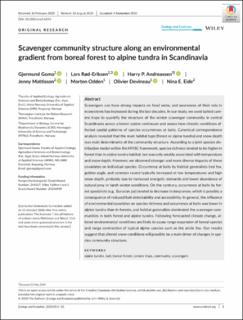| dc.contributor.author | Gomo, Gjermund | |
| dc.contributor.author | Rød-Eriksen, Lars | |
| dc.contributor.author | Andreassen, Harry Peter | |
| dc.contributor.author | Mattisson, Jenny | |
| dc.contributor.author | Odden, Morten | |
| dc.contributor.author | Devineau, Olivier | |
| dc.contributor.author | Eide, Nina Elisabeth | |
| dc.date.accessioned | 2020-09-29T06:22:54Z | |
| dc.date.available | 2020-09-29T06:22:54Z | |
| dc.date.created | 2020-09-28T17:22:48Z | |
| dc.date.issued | 2020 | |
| dc.identifier.issn | 2045-7758 | |
| dc.identifier.uri | https://hdl.handle.net/11250/2680075 | |
| dc.description.abstract | Scavengers can have strong impacts on food webs, and awareness of their role in ecosystems has increased during the last decades. In our study, we used baited camera traps to quantify the structure of the winter scavenger community in central Scandinavia across a forest–alpine continuum and assess how climatic conditions affected spatial patterns of species occurrences at baits. Canonical correspondence analysis revealed that the main habitat type (forest or alpine tundra) and snow depth was main determinants of the community structure. According to a joint species distribution model within the HMSC framework, species richness tended to be higher in forest than in alpine tundra habitat but was only weakly associated with temperature and snow depth. However, we observed stronger and more diverse impacts of these covariates on individual species. Occurrence at baits by habitat generalists (red fox, golden eagle, and common raven) typically increased at low temperatures and high snow depth, probably due to increased energetic demands and lower abundance of natural prey in harsh winter conditions. On the contrary, occurrence at baits by forest specialists (e.g., Eurasian jay) tended to decrease in deep snow, which is possibly a consequence of reduced bait detectability and accessibility. In general, the influence of environmental covariates on species richness and occurrence at baits was lower in alpine tundra than in forests, and habitat generalists dominated the scavenger communities in both forest and alpine tundra. Following forecasted climate change, altered environmental conditions are likely to cause range expansion of boreal species and range contraction of typical alpine species such as the arctic fox. Our results suggest that altered snow conditions will possibly be a main driver of changes in species community structure. alpine tundra, bait, boreal forest, camera traps, community, scavengers | en_US |
| dc.language.iso | eng | en_US |
| dc.publisher | Wiley | en_US |
| dc.rights | Navngivelse 4.0 Internasjonal | * |
| dc.rights.uri | http://creativecommons.org/licenses/by/4.0/deed.no | * |
| dc.title | Scavenger community structure along an environmental gradient from boreal forest to alpine tundra in Scandinavia | en_US |
| dc.type | Journal article | en_US |
| dc.type | Peer reviewed | en_US |
| dc.description.version | publishedVersion | en_US |
| dc.source.journal | Ecology and Evolution | en_US |
| dc.identifier.doi | 10.1002/ece3.6834 | |
| dc.identifier.cristin | 1834499 | |
| dc.relation.project | Norges forskningsråd: 244554 | en_US |
| dc.relation.project | Andre: Norwegian Environment Agency | en_US |
| dc.relation.project | EU/EU Life | en_US |
| dc.relation.project | EU/EU/Interreg Sweden-Norway (Felles fjellrev I og 2) | en_US |
| dc.description.localcode | © 2020 The Authors. Ecology and Evolution published by John Wiley & Sons Ltd This is an open access article under the terms of the Creative Commons Attribution License, which permits use, distribution and reproduction in any medium, provided the original work is properly cited. | en_US |
| cristin.ispublished | true | |
| cristin.fulltext | original | |
| cristin.qualitycode | 1 | |

